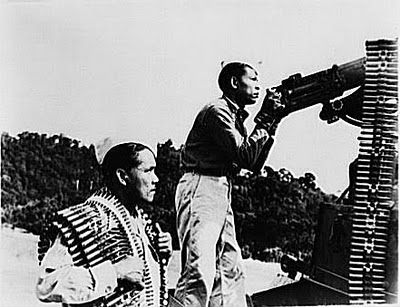These guys were just so good at the battlefield rather than the Americans I think? During the retreat in Bataan, the Philippine Division held the Japs for 4 months after McArthur escapes. I will post some photos soon if I have time. 
The Philippine Scouts were indeed very good fighters and inflicted unexpectedly heavy losses on the Japanese forces in fierce fighting on Luzon. They were part of the mixed Filipino and American “Philippine Division” which was later reconstituted and designated the 12th Infantry Division. The Philippine Scouts were the only completely trained and equipped Filipino troops in MacArthur’s Command in the early fighting on Luzon and formed the backbone of the Bataan defense in early 1942.
The Philippine Division consisted of the 31st., 45th., and 57th., infantry regiments, the 23rd., and 24th., field artillery regiments, and support troops. The officers were mostly American, but there were 15 Filipino officers scattered throughout the division. The 31st. infantry regiment was made up of Americans, and the other regiments were mostly Filipino troops. Total complement for the division was 10,473, of which 7,921 were Filipino.
The 31st. Infantry Regiment was largely responsible for holding the Japanese invaders away from Bataan long enough to allow other units of MacArthur’s command to withdraw onto the Bataan peninsula. The defense of Bataan began on Jan. 6, with the Philippine Division as the principle major unit of the defending army. On March 11, MacArthur left Luzon by PT boat, under orders form Washington, vowing to return. On April 9, General King, the commander of the Bataan defenders was forced to surrender his 70,000 man (16,000 Americans, 54,000 Filipinos) force due to inadequate food, ammo, and medical supplies. The 31st., and 57th. infantry regiments were lost in fierce fighting the day before the surrender and the 45th. regiment was surrendered the following day. The surviving Filipino soldiers of the Philippine Division participated in the Bataan Death March, and many were murdered by the Japanese who seemed to single out the Filipinos for especially sadistic treatment.
The performance of the Philippine Division was truly inspiring, particularly when set against the defeats suffered by British, Australian, and Indian troops in Malaya. The first three Army MOA’s in WW II were awarded to Philippine Division members. Many of the Philippine Scouts who avoided capture on Bataan joined the anti-Japanese resistance that flourished on Luzon and other Philippine islands and distinguished themselves in fighting for independence.
The Philippine Scouts were indeed very good fighters and inflicted unexpectedly heavy losses on the Japanese forces in fierce fighting on Luzon. They were part of the mixed Filipino and American “Philippine Division” which was later reconstituted and designated the 12th Infantry Division. The Philippine Scouts were the only completely trained and equipped Filipino troops in MacArthur’s Command in the early fighting on Luzon and formed the backbone of the Bataan defense in early 1942.
The Philippine Division consisted of the 31st., 45th., and 57th., infantry regiments, the 23rd., and 24th., field artillery regiments, and support troops. The officers were mostly American, but there were 15 Filipino officers scattered throughout the division. The 31st. infantry regiment was made up of Americans, and the other regiments were mostly Filipino troops. Total complement for the division was 10,473, of which 7,921 were Filipino.
The 31st. Infantry Regiment was largely responsible for holding the Japanese invaders away from Bataan long enough to allow other units of MacArthur’s command to withdraw onto the Bataan peninsula. The defense of Bataan began on Jan. 6, with the Philippine Division as the principle major unit of the defending army. On March 11, MacArthur left Luzon by PT boat, under orders form Washington, vowing to return. On April 9, General King, the commander of the Bataan defenders was forced to surrender his 70,000 man (16,000 Americans, 54,000 Filipinos) force due to inadequate food, ammo, and medical supplies. The 31st., and 57th. infantry regiments were lost in fierce fighting the day before the surrender and the 45th. regiment was surrendered the following day. The surviving Filipino soldiers of the Philippine Division participated in the Bataan Death March, and many were murdered by the Japanese who seemed to single out the Filipinos for especially sadistic treatment.
The performance of the Philippine Division was truly inspiring, particularly when set against the defeats suffered by British, Australian, and Indian troops in Malaya. The first three Army MOA’s in WW II were awarded to Philippine Division members. Many of the Philippine Scouts who avoided capture on Bataan joined the anti-Japanese resistance that flourished on Luzon and other Philippine islands and distinguished themselves in fighting for independence.
Indeed very good details about the 12th! Thank you Wizard! You’re one birght guy! 
Soldiers of the 12th “Philippine” Infantry Division (led by American Officers) with a caliber .50 heavy machine gun, face the oncoming Japanese landing, in Bauang (Lingayen Gulf) Luzon Island - Philippines, on December 22nd, 1941.

